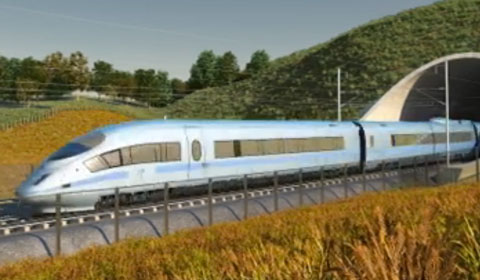HS2 and BREEAM
In February 2018, High Speed 2 (HS2) became the UK’s first infrastructure project to be awarded a BREEAM Infrastructure (pilot) Scheme Certificate for its ambitious sustainability strategy on Phase 1 of the project.
The assessment demonstrates that HS2 is committed to going beyond enhancement and protection of the environment, to address the key social and economic impacts of the development. It includes features such as working in harmony with communities, being a great neighbour, putting safety and wellbeing at the heart of the project, and building sustainable economic benefits for the whole of the UK, such as better skills and career opportunities for a new generation.
HS2 Environment Director, Peter Miller, said:
"We are very pleased to receive this BREEAM Infrastructure certificate. Our goal with HS2 is to design and build the most sustainable high-speed railway of its kind in the world, working in partnership with our supply chain and local communities to leave a positive legacy for future infrastructure projects both in the UK and beyond. This certificate is a testament to our sustainability commitments and to the lasting benefits of the HS2 project.”
BREEAM Infrastructure is part of the international BREEAM family of sustainability standards for buildings and infrastructure. Later in 2018, the best of BREEAM Infrastructure will be brought together with market leading sustainable infrastructure scheme CEEQUAL to provide a new world class international scheme for the future called CEEQUAL (2018). The CEEQUAL (2018) development process includes significant valuable feedback and learning from the application of the BREEAM Infrastructure pilot to HS2.
BRE Director of Infrastructure Chris Broadbent said:
"From 2014 HS2 was the first project to engage with BRE in the development of BREEAM Infrastructure working with us to pioneer a new approach to a sustainability strategy which applies right across the entire HS2 project. This is a first for the UK and it will set the standards for future infrastructure projects around the world."
This article was originally published here by BRE on 9 February 2018.
[edit] Find out more
[edit] Related articles on Designing Buildings Wiki
Featured articles and news
A change to adoptive architecture
Effects of global weather warming on architectural detailing, material choice and human interaction.
How big is the problem and what can we do to mitigate the effects?
Overheating guidance and tools for building designers
A number of cool guides to help with the heat.
The UK's Modern Industrial Strategy: A 10 year plan
Previous consultation criticism, current key elements and general support with some persisting reservations.
Building Safety Regulator reforms
New roles, new staff and a new fast track service pave the way for a single construction regulator.
Architectural Technologist CPDs and Communications
CIAT CPD… and how you can do it!
Cooling centres and cool spaces
Managing extreme heat in cities by directing the public to places for heat stress relief and water sources.
Winter gardens: A brief history and warm variations
Extending the season with glass in different forms and terms.
Restoring Great Yarmouth's Winter Gardens
Transforming one of the least sustainable constructions imaginable.
Construction Skills Mission Board launch sector drive
Newly formed government and industry collaboration set strategy for recruiting an additional 100,000 construction workers a year.
New Architects Code comes into effect in September 2025
ARB Architects Code of Conduct and Practice available with ongoing consultation regarding guidance.
Welsh Skills Body (Medr) launches ambitious plan
The new skills body brings together funding and regulation of tertiary education and research for the devolved nation.
Paul Gandy FCIOB announced as next CIOB President
Former Tilbury Douglas CEO takes helm.
UK Infrastructure: A 10 Year Strategy. In brief with reactions
With the National Infrastructure and Service Transformation Authority (NISTA).
Ebenezer Howard: inventor of the garden city. Book review.
Airtightness Topic Guide BSRIA TG 27/2025
Explaining the basics of airtightness, what it is, why it's important, when it's required and how it's carried out.























